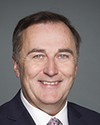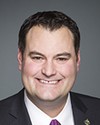Mr. Chairman and members of the committee, good morning.
I wish to acknowledge that we meet today on Algonquin territory, land that has never been ceded or surrendered. I think the Algonquin nation for the privilege to meet here to speak to all of our warrior veterans, both aboriginal and non-aboriginal. I wish to also acknowledge a personal friend and comrade, Mr. Bill Black, a Korean veteran well respected in the veterans community.
As president of the Aboriginal Veterans Autochtones, I once again appear here to represent the aboriginal veterans from my organization as well as veterans from the Congress of Aboriginal Peoples. I take my responsibility very seriously and thank the committee members for allowing me once again to speak on veterans' issues.
I'm here to discuss the delivery of services for veterans. I will speak only on matters that I feel need to be addressed, only on issues that need to be mentioned on behalf of aboriginal veterans from coast to coast to coast. We do not wish to be classed only as veterans. Rather, we take pride in our service to Canada and our service with all Canadian veterans. With them we stand united.
A decade ago, Veterans Affairs introduced the veterans transition action plan, which was designed to assist veterans leaving the Canadian Armed Forces and moving into civilian life. This plan has certainly had its challenges, but for the most part it has provided the help veterans needed to transition out of the Canadian Armed Forces.
Many veterans moved smoothly through the programs and received the entitlements and benefits. There were some, though, who faced obstacles. The delay of services or benefits may well have been concentrated in the transfer of medical documents between the Department of National Defence and Veterans Affairs Canada. I am not aware if this problem has been rectified, but I know that coordination and effective communication between release sections and Veterans Affairs caseworkers will certainly help to alleviate any problems.
Veterans Affairs announced recently that it will be hiring enough new caseworkers to reduce the caseworker-to-client ratio to 25:1. This could be a positive factor in improving wait times and document transfers.
The closing of offices by the previous government had an adverse effect on some of our aboriginal veterans, notably those in the Saskatoon area. This was the only office that was reasonably close to our first nations or to rural communities where Métis lived as well, although in some cases the drive to get to that location was four hours. When the office closed, veterans were forced to deal with Veterans Affairs online—if they had that capability—or by phone. With the reopening of this office, we hope that caseworkers will also be required to visit face to face for consultations.
I would add that the vast majority of veterans in Canada did not support the move to Service Canada for veterans' services. The main reason was that the person on the phone was not conversant with our policies and procedures, nor did they understand the scope of any of the veterans' issues.
On the issue of reaching out to less populated areas—our remote first nations, rural communities, and communities in the north—in the four years I've been involved with this committee, I haven't seen much movement on the key issues put forward by my organization, by the Legion, or by other veterans' groups.
For example, I advocated for veterans in our rural and isolated communities, communicating with them on benefits and entitlements. I explained that the technology enjoyed by mainstream Canadians is not necessarily the norm in remote communities and that we needed to develop a better plan to deal with the issues. I was happy to hear last week at the minister's summit that there is apparently a plan to answer the communication problems in the north. Although we did not hear specifics, it would appear that somebody has put it on the table, and my hope is that there will be no delays in the implementation of this plan, which has to include face-to-face consultation.
When we speak of post-traumatic stress disorder and mental health in general, I believe that OSISS offices across the country are in most cases meeting the needs of those veterans who have sought help. I can only hope more injured service personnel take advantage of these offices.
Families of veterans who are suffering must be included in the treatment of the veteran, because they are the ones closest to the veteran and are also affected by that injury. Our aboriginal communities see post-traumatic stress disorder, and those affected by it, as being disconnected from mother earth. The warrior needs to be reconnected, and our ceremonies such as sweat lodges help our wounded warriors to cope and to and move on down the path of healing to deal with those demons and eventually reconnect with mother earth, their families, their friends, and all relations.
The vocational rehabilitation program appears to have a great deal of positive components to assist not only the veteran but also the families of veterans, depending on the degree of injury. It is not reasonable to have a policy that must be activated after release within two years of that release date. Veterans need to be healed before they can do any type of vocational rehab, or any type of program, or even apply for it. You must take into account that with some of the more severe cases, be they physical or mental injuries or a combination of the two, it may be wise to consider interaction with caseworkers, health care professionals, and others involved directly with the veteran and the veteran's family to decide if and when rehabilitation is practical. It may very well be longer than the current two-year policy.
Veterans within my organization living in Quebec, as well as other veterans' groups, were disappointed to see that the Ste. Anne's Hospital was transferred to provincial control. The so-called traditional veterans are few in number, and the government feels it's time to change the way it deals with veterans seeking long-term care. There will be no veteran-specific floors in the provinces, and the fear is that obtaining space in the provincial system will be slow at best and that veterans will be treated like other people seeking the same type of care.
The department must remember that we still have veterans and that facilities for long-term care should be available for veterans, at least as a first option. It may be felt that at this time the need may not be critical, but the future will see veterans counting on these facilities to be there when they feel the need. There may very well be a tidal wave of veterans coming near the time they will require long-term care facilities. How will the government cope with this reality when that time comes?
Effective communication is the cornerstone to ensure success. If you can communicate your message to everyone, and it is understood, then you have achieved the first and most important step in providing care to veterans.
I recently sat with two retired chief warrant officers, with a combined service of approximately 65 years of regular force service. Their response to communicating with service personnel was to go through the leadership that is already there in the Canadian Armed Forces.
One of their suggestions was—of course, being chief warrant officers they would use this one—that if Veterans Affairs Canada wants to ensure information regarding benefits and programs are available, chair a base chief warrant officers' conference once a year for three to five days and give them the information on all of the programs and benefits and entitlements that Canadian Armed Forces members may be entitled to once they move from the military. Then have those chief warrant officers, when they go back to those bases, deliver or disseminate the information to the units within their base structure.
I am quite sure there are other ways to do this, but as a soldier and as a leader of soldiers, I was responsible for the welfare for those under my command. Leaders will always look after their soldiers, and that includes communication.
Mr. Chairman, committee members, and fellow veterans, thank you. Meegwetch, marsi, merci, qujannamiik, all my relations.



